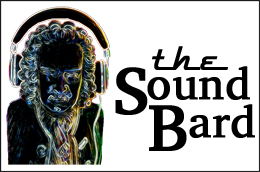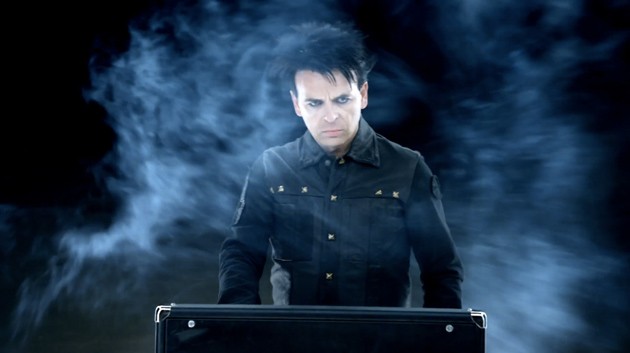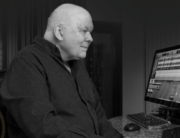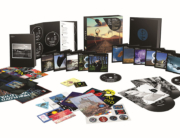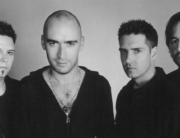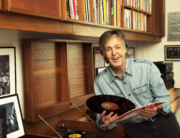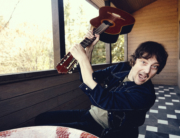BY MIKE METTLER – OCTOBER 21, 2014

Gary Numan, still looking toward the future.
“48k is a very high standard. If I sing something in the studio and then I play it back that way, it sounds exactly the same,” says electronic music pioneer Gary Numan. “The thing that’s most important to me is the sounds of the songs and the songs themselves. If you’ve got a great song, whether it’s in 48 or 96 [kHz] or higher, it’s still a great song. People will listen to that more than they will the clinical side of it. When we moved to CDs, I thought that was a lovely step forward. And then when we moved onto digital music after that, I thought it was fantastic. I think the difference in quality in dropping from one bit rate to another is that it will only be very noticeable if you’re listening to it on the very best systems. You can spend a huge amount of money and time worrying that your record is at the highest possible level it can be, and then somebody will be listening to it on some shit headphones and an iPad.”
That’s just a taste of my interview with Numan, which you can read in full over on Digital Trends. There, he and I discuss more about sound quality, the art of making loops back in the day, his current music-making methods and gear, and his take on the modern electronic scene.
But here, we get to talk even more. The following is SoundBard-exclusive content, wherein Numan, 56, and I delve into the sonic choices and the gear behind his indelible ode to late-20th-Century paranoia, “Cars,” plus the possibility of working in surround sound, and how a sampled whisper can become a scream.
Mike Mettler: Let’s get into “Cars.” When The Pleasure Principle (1979) was remastered for CD by John Dent in 1998, could you tell the difference in sound quality?
Gary Numan: Oh yes. There was so much more punch to it. It’s slightly more aggressive, and there’s more attack to it. It has much more presence, obviously. I thought they lifted “Cars” slightly out of the muddy sound that it had before. They cleaned it up, and I think it works well digitally.
Mettler: And you still have the Shergold Modulator [guitar] you played on the song, right?
Numan: Yeah, yeah, I do! It’s in the corner of my studio. I don’t use it anymore, but I’ve kept it. If I look around here. . . hold on. . . (pauses) Yep, there it is! (chuckles) It’s just straight in the corner from where I’m sitting now, yeah!
Mettler: That’s a Hall of Fame piece of equipment if ever there was one.
Numan: (laughs heartily) Yeah! I’ll be happy to lend it to the Hard Rock, or something like that. But it’s something that’s very special to me, and I would never want to get rid of it.
Mettler: Some people may not realize that, when it comes to guitars, you’ve been a Les Paul guy since the very beginning.
Numan: Right! I’ve got a Les Paul Sunburst since I was about 15 or 16. Very lucky. My mom and dad were very kind to me and got me this really great guitar, and I’ve had it ever since. I use it now, and I use it on tour. It’s been on every album I’ve ever made. Every song I’ve ever recorded with guitar, it’s on. It sits in my studio next to the Shergold. I use it pretty much all the time. In fact, the Les Paul is the longest lasting object I’ve ever owned. It’s the only thing I’ve ever owned — including cars, airplanes, and houses — that I’d never ever want to sell, ever. I’ll have that, unless it gets stolen, on the day I die. And that’s not true of anything else, not even the Shergold. That guitar has been with me through every up and down of my adult life, and of course my late teenage years as well. It means so much to me because of that. I absolutely love it. I’m not a really good guitar player, but I do love it. It almost feels like — you know when you’ve been through a lot and you’ve had a very up and down kind of life? You’ve had some really good moments and some really unpleasant moments. That guitar is the one thing that I’ve had that’s been consistent. Even more than people. It’s forever.
Mettler: What year is it?
Numan: I got it new, in ’73. The other thing about that particular guitar — when I was at school, my friend had a book called The Gibson Story. And there was a reference in that book to so many guitars that Gibson put out, some they would stamp the number 2 at the top of the neck, in the machine head. They were making fun of me going, “Wouldn’t it be funny if your guitar had a 2, like a reject.” I went home, and sure enough it was! It had one of these stubs on the neck, and it made me love it all the more! My guitar is actually a reject from Gibson. It’s been on #1 records and #1 albums, and it’s been with me forever. It makes it all the more endearing.
Mettler: Ok, so I’m curious — since you’d had that Les Paul for so long, why did you write the signature riff for “Cars” on a different guitar, the Shergold?
Numan: It was just circumstance, really. The day I wrote “Cars,” I’d been to London, and I bought the Shergold specifically because I wanted to learn how to play bass better. There were certain things I wanted to try that the bass player I had at the time was a bit uncomfortable with. So I thought I’d just learn it myself.
So I went to London, brought the guitar home, sat down in the lounge, and took it out of its case and put it on my lap, holding it up on my knee. I had no strap for it. And the very, very first thing I did was, “Doo-doot doo-doooot,” and I thought, “Oh, that’s ok.” I played that for a bit, and then the next bit, and the next bit. It took me about 10 minutes at the most, and I had the whole structure of “Cars” — the quickest song I ever wrote. I didn’t sit down to write a song; I was just doodling. I don’t even think I tuned it properly. I really just took it out of the case and played it. Those were the very first four notes that I played, and that was “Cars.” It was just one of those things. To put it properly, it was the most amazing lucky moment that I think anyone could wish to ever have.
Mettler: Some of the best songs are written that fast. You don’t have to overthink it, and then it’s here forever.
Numan: Yeah. For me, it was a life-changing moment, obviously. That song’s become very well-known, very successful. Even now, every week, it’s on an advert or a trailer or something. It still works.
Mettler: When you demo’ed “Cars” for record labels, it was off a cassette. Did you feel something was missing when people heard it that way?
Numan: Uh, yeah. When you hear it in the studio, there’s weight to it. There’s bottom end, and there’s clarity. You put that on a cassette, and it’s played on some horrible portable system in a record exec’s office. There’s no weight, no clarity of the top end, and it’s slightly muffly, but that was what you had. That was normal. If you could imagine somebody having a medium-sized blanket over their head, it sounded a bit like that. These days, it would be completely unacceptable.
Mettler: Given its ongoing presence and impact, every generation is going to discover “Cars.” Actually, I’d love to hear “Cars” in surround sound. Have you ever thought about that?
Numan: Going back to work on old songs is something I think of pretty rarely, if at all. But the whole surround thing was presented to me when we were making [the soundtrack to the animated film] From Inside. I was talking to John [Bergin], the director, and Brian [McNelis], the guy who produced it, and this whole idea came up about working in a studio that was 5.1- or even 7.1-capable. For me, it would be a wise move, something for me to get into. If I put 5.1 or 7.1 in my studio, it would be a natural thing for me to work on my own albums in that format. So maybe, if I had the spare time to do it. It does need to be in my studio as an option. I need to understand how it works, and become familiar with the techniques to make it a viable thing.
Mettler: The type of layering you do in your recordings would lend itself quite well to surround sound, I think.
Numan: I’m thinking about it. When I walk into a studio and sit down to work, I expect to come out at the end of the day with noises and sounds, something that I’ve never heard before; something new. I’m not going in there to try and create something I’ve done before or try to refine something. If I don’t do something I think is new, then I’m pretty grumpy the rest of the evening, because I feel I’ve wasted the day, and wasted the opportunity. I’d like to come out with one sound, or preferably more, of something I haven’t heard before that I can then try to find a musical home for, because a lot of the sounds you come up with are not very musical; they’re just noise. You have to find a way of using that noise and turn it into music. You wrap it and embed it in melody. It’s kind of cool — a year or so down the line when an album is finished, you get to hear those little noises you came up with by scratching a comb across a glass.
I remember once spending maybe nearly a week just whispering. I was writing down different phrases, and whispering them at a low-energy level into a recorder, and then manipulating those sounds so that I had hundreds and hundreds of them. Some of them sounded like the devil himself talking! But some of them were ethereal, depending on how you treated them. They were really quite amazing things to do. I didn’t end up using that many of them, but nonetheless, I thought that was a really good week — trying to build up a cupboardful of interesting sounds I could turn to that could have an application in a song as the months progressed.
I still find that sort of thing fascinating, and that to me is why I think film-score work is so suited for me. I’m thinking about my musical future. There are things I’ve pushed aside and not really developed, and now I’m making time to do these other projects. I’m just exploring some of my hobbies, I guess — things I’d like to actually do in a more creative and fuller way.
